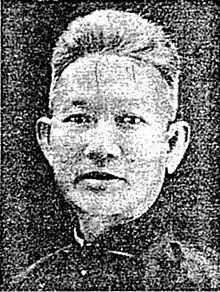Tản Đà
Nguyễn Khắc Hiếu (阮克孝), pen name Tản Đà (chữ Hán: 傘沱, 19 May 1889 – 7 June 1939) was a Vietnamese poet.[1]

He used both traditional Sino-Vietnamese forms and European influences and was a transitional figure between the turn of the 1890s such as Tú Xương and Nguyễn Khuyến and the "New Poetry" movement of the 1930s.[2]
Late in his life he published a literary magazine in Hanoi, An Nam Tạp Chí (Annam Magazine), but when this got into financial difficulty, he readily accepted an invitation to come South and write for the new Đông Pháp Thời Báo (Indochina Times) in Saigon.[3]
Although popular with the newspaper-buying public, his poetry was criticised by the young poets of the Hanoi-based Thơ mới "New Poetry" movement influenced by French poets such as Baudelaire.[4]
References
- Bruce M. Lockhart, William J. Duiker The A to Z of Vietnam, 2010, p.353 entry
- Vietnamese Tradition on Trial, 1920-1945 - Page 447 David G. Marr - 1984 "Tan Da Van Van [Tan Da's Poetry] 2 vols. Hanoi: Huong Son, 1952. First published in 1941-48. The author provided something of a bridge between turn-of-the-century poets like Tu Xuong and Nguyen Khuyen and the “New Poetry” (Tho Moi) ."
- The Birth of Vietnamese Political Journalism: Saigon, 1916–1930 - Page 167 Philippe M. F. Peycam - 2012 "He first convinced the famous elderly Hanoi-based poet Nguyễn Khắc Hiếu (pen name Tản Đà) to come down to Saigon. Tản Đà was an eccentric figure whose poems celebrated the virtues of free love and wine and evoked to many of his compatriots a past innocence. His literary magazine, An Nam Tạp Chí (Vietnam magazine), was in financial difficulty.... To the readers' delight, Tản Đà's poetry and literary articles were now regularly published."
- Kim Ngoc Bao Ninh - A World Transformed: The Politics of Culture in Revolutionary Vietnam - Page 23 2002 "New Poetry began its life with a clear demarcation between itself and the old form; its supporters vilified poets in the old tradition. The targets of this devastating attack included the venerable Tan Da, himself a transitional figure between the ..."